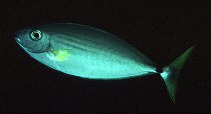| Family: |
Acanthuridae (Surgeonfishes, tangs, unicornfishes), subfamily: Nasinae |
| Max. size: |
30 cm SL (male/unsexed) |
| Environment: |
reef-associated; marine; depth range 8 - 55 m |
| Distribution: |
Indo-West Pacific: Mozambique to the Philippines. |
| Diagnosis: |
Dorsal spines (total): 5-5; Dorsal soft rays (total): 28-30; Anal spines: 2-2; Anal soft rays: 28-28. Fresh specimens with yellow caudal fin and blackish peduncular plate; preserved specimens uniform grey in color and dark fins (pectorals pale). Oblique groove on side of snout below nostrils, its length about equal to length of naked area enclosing nostrils (Ref 9808).
Description: Characterized further by having black caudal spine; absence of horn or protuberance on forehead; single plate with large, sharp spine on each side of caudal peduncle; greatest depth of body 2.9-3.3 in SL (Ref. 90102). |
| Biology: |
Inhabits coastal to outer reef slopes, usually swimming along upper edges of drop-offs in small schools (Ref. 48637). Descends from the water column to the reef front to be cleaned by Labroides dimidiatus (Ref. 4974). Feeds on benthic algae (Ref. 3145). Forms aggregations, feeding on zooplankton well above the bottom over or in the immediate vicinity of reefs. Males exhibit rapid and striking changes in color pattern during courtship (Ref. 10671). |
| IUCN Red List Status: |
Least Concern (LC); Date assessed: 06 May 2010 Ref. (130435)
|
| Threat to humans: |
harmless |
Source and more info: www.fishbase.org. For personal, classroom, and other internal use only. Not for publication.

